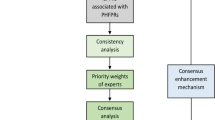Abstract
In this paper we present a consensus-theoretic framework based on weighted description logic and on a consensus modelling approach, which is used to retrieve a consistent decision among experts along multi-attributes. We will show that the integration of these two approaches is best suited for consensus building between (human) experts, especially when their preferences are not easily found or disturbed by coincidental influences. As an application of our methodology, we interviewed experts (in our case students) on the choice of means of transport. One time we asked them directly about their preferences and another time we asked them about their attitudes towards ecology, economy, and others. We will show how these two approaches of gathering data lead to different constructed hypothetical consensus and how the additional use of weighted description logic reveals other diverse insights. Our consensus-theoretical methodology begins with the modelling of basic attribute characteristics, mapping them into fuzzy preference relations and thus supports the decision-making process with respect to consensus.
Access this chapter
Tax calculation will be finalised at checkout
Purchases are for personal use only
Similar content being viewed by others
References
Acar, E., Fink, M., Meilicke, C., Thome, C., Stuckenschmidt, H.: Multi-attribute decision making with weighted description logics. IFCoLog J. Log. Its Appl. 4, 1973–1995 (2017)
Schnattinger, K., Walterscheid, H.: Opinion mining meets decision making: towards opinion engineering. In: Fred, A., Filipe, J. (eds.) IC3K17 – Proceedings of the 9th International Joint Conference on Knowledge Discovery, Knowledge Engineering and Knowledge Management, vol. 1, pp. 334–341 (2017)
Alonso, S., Cabrerizo, F., Chiclana, F., Herrera, F.: Group decision making with incomplete fuzzy linguistic preference relations. Int. J. Intell. Syst. 24, 201–222 (2009). https://doi.org/10.1002/int.20332
Xu, K., Liao, S.S., Li, J., Song, Y.: Mining comparative opinions from customer reviews for competitive intelligence. Decis. Support Syst. 50, 743–754 (2011)
Herrera-Viedma, E., Alonso, S., Chiclana, F., Herrera, F.: A consensus model for group decision making with incomplete fuzzy preference relations. IEEE Trans. Fuzzy Syst. 15(5), 863–877 (2007)
Hsu, H.-M., Chen, C.-T.: Aggregation of fuzzy opinions under group decision making. Fuzzy Sets Syst. 79, 279–285 (1996)
Kacprzyk, J., Fedrizzi, M., Nurmi, H.: Group decision making and consensus under fuzzy preferences and fuzzy majority. Fuzzy Sets Syst. 49, 21–31 (1992). https://doi.org/10.1016/0165-0114(92)90107-f
Nurmi, H.: Approaches to collective decision making with fuzzy preference relations. Fuzzy Sets Syst. 6, 249–259 (1981)
Tanino, T.: Fuzzy preference orderings in group decision making. Fuzzy Sets Syst. 12, 117–131 (1984). https://doi.org/10.1016/0165-0114(84)90032-0
Xu, Z.: A method based on linguistic aggregation operators for group decision making with linguistic preference relations. Inf. Sci. 166, 19–30 (2004)
Hardin, G.: The tragedy of the commons. Science 162(13), 1243–1248 (1968)
Walterscheid, H.: Who owns Digital Data? Working and Discussion Paper DHBW Loerrach(4) (2017)
Stiglitz, J.: Economics of the Public Sector, 3rd edn. WW Norton & Co., New York (2000)
Thaler, R., Sunstein, C.: Nudge: Improving Decisions About Health, Wealth, and Happiness. Penguin (2009). https://doi.org/10.1007/s10602-008-9056-2
Aprem, A., Krishnamurthy, V.: Online social media: a revealed preference framework. IEEE Trans. Sig. Process. 65(7), 1869–1880 (2017)
Sun, S., Luo, C., Chen, J.: A review of natural language processing techniques for opinion mining systems. Inf. Fusion 36, 10–25 (2017)
Baader, F., McGuinness, D., Narci, D., Patel-Schneider, P.: The Description Logic Handbook: Theory, Implementation, and Applications. Cambridge University Press, New York (2003). https://doi.org/10.1017/CBO9780511711787
Hahn, U., Schnattinger, K.: Towards text knowledge engineering. In: AAAI 1998 – Proceedings of the 15th National Conference on Artificial Intelligence, pp. 524–531 (1998)
Schnattinger, K., Hahn, U.: A sketch of a qualification calculus. In: FLAIRS – Proceedings of the 9th Florida Artificial Intelligence Research Symposium, pp. 198–203 (1996)
Schnattinger, K., Hahn, U.: Quality-based learning. In: ECAI 1998 – Proceedings of the 13th Biennial European Conference on Artificial Intelligence, pp. 160–164 (1998)
Yager, R.: Quantifier guided aggregation using OWA operators. Int. J. Intell. Syst. 11(11), 49–73 (1996)
Yager, R.R., Filev, D.P.: Operations for granular computing: mixing words and numbers. In: IEEE International Conference on Fuzzy Systems, vol. 2, no. 1, pp. 123–128 (1998). https://doi.org/10.1109/fuzzy.1998.687470
Zadeh, L.A.: A computational approach to fuzzy quantifiers in natural languages. Comput. Math. Appl. 9(1), 149–184 (1983)
Chuan, Y., Schechter, L.: Stability of experimental and survey measures of risk, time, and social preferences: a review and some new results. J. Dev. Econ. 117, 151–170 (2015)
Author information
Authors and Affiliations
Corresponding author
Editor information
Editors and Affiliations
Rights and permissions
Copyright information
© 2018 Springer International Publishing AG, part of Springer Nature
About this paper
Cite this paper
Mueller, N., Schnattinger, K., Walterscheid, H. (2018). Combining Weighted Description Logic with Fuzzy Logic for Decision Making. In: Medina, J., Ojeda-Aciego, M., Verdegay, J., Perfilieva, I., Bouchon-Meunier, B., Yager, R. (eds) Information Processing and Management of Uncertainty in Knowledge-Based Systems. Applications. IPMU 2018. Communications in Computer and Information Science, vol 855. Springer, Cham. https://doi.org/10.1007/978-3-319-91479-4_11
Download citation
DOI: https://doi.org/10.1007/978-3-319-91479-4_11
Published:
Publisher Name: Springer, Cham
Print ISBN: 978-3-319-91478-7
Online ISBN: 978-3-319-91479-4
eBook Packages: Computer ScienceComputer Science (R0)




